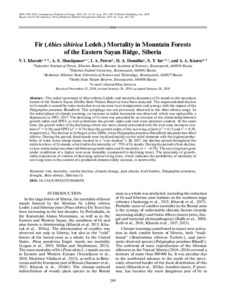Fir (Abies sibirica Ledeb.) Mortality in Mountain Forests of the Eastern Sayan Ridge, Siberia
URI (для ссылок/цитирований):
https://link.springer.com/article/10.1134%2FS199542551904005Xhttps://elib.sfu-kras.ru/handle/2311/128476
Автор:
Kharuk, V. I.
Shushpanov, A. S.
Petrov, I. A.
Demidko, D. A.
Im, S. T.
Knorre, A. A.
Коллективный автор:
Институт космических и информационных технологий
Институт экологии и географии
Базовая кафедра геоинформационных систем
Кафедра географии
Дата:
2019-07Журнал:
Contemporary Problems of EcologyКвартиль журнала в Scopus:
Q3Квартиль журнала в Web of Science:
Q4Библиографическое описание:
Kharuk, V. I. Fir (Abies sibirica Ledeb.) Mortality in Mountain Forests of the Eastern Sayan Ridge, Siberia [Текст] / V. I. Kharuk, A. S. Shushpanov, I. A. Petrov, D. A. Demidko, S. T. Im, A. A. Knorre // Contemporary Problems of Ecology. — 2019. — Т. 12 (№ 4). — С. 299-309Текст статьи не публикуется в открытом доступе в соответствии с политикой журнала.
Аннотация:
The radial increment of Abies sibirica Ledeb. and mortality dynamics of fir stands in the mountain forests of the Eastern Sayan (Stolby State Nature Reserve) have been analyzed. The unprecedented decline in fir stands is caused by water stress due to an increase in air temperature and synergy with the impact of the Polygraphus proximus Blandford. This xylophage was not previously observed in the Abies sibirica range. In the initial phase of climate warming, an increase in radial increment was observed, which was replaced by a depression in 1985–2017. The declining of fir trees was preceded by an increase in the relationship between growth index and SPEI, as well as between the growth index and root-zone moisture content. At the same time, the growth index of the declining cohort was more closely associated with the root zone moisture content (r2 = 0.56) and SPEI (r2 = 0.74) than the growth index of the surviving cohort (r2 = 0.15 and r2 = 0.39, respectively). The decline in fir began in the 2000s, when Polygraphus proximus Blandford attacked trees Abies sibirica. During this period, dead stands were localized mainly on the relief elements with the highest probability of water stress (steep slopes located in a “rain shadow”). By 2017, the decline spread throughout the entire territory of fir stands, which led to the mortality of ~75% of fir stands. During the period of tree decline, a close relationship was observed between growth index and fir mortality (r = –0.79). The surviving trees grew under conditions of a higher root-zone humidity (compared to declining trees). The proximity of growth-index trajectories of cohorts of declining and surviving trees, which indicates the probability of mortality of surviving trees in the context of a predicted climate aridity increase, is noteworthy.

